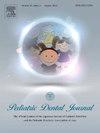日本儿童牙医和牙科麻醉师对儿童牙科治疗全身麻醉的认识差异
IF 0.8
Q4 DENTISTRY, ORAL SURGERY & MEDICINE
引用次数: 0
摘要
在日本,使用全身麻醉进行牙科治疗(GAD)在智力残疾患者中很常见。然而,广泛性焦虑症在无智力障碍的不合作儿童患者中并不常见。目的本研究旨在验证儿童牙医和牙科麻醉师对广泛性焦虑症接受程度的差异导致其在不合作儿童中的应用有限的假设。材料与方法对获得日本儿科牙科学会(JSPD)和日本牙科麻醉师学会(JDSA)认证的牙医进行问卷调查。问卷内容包括儿童全麻镇静的实施和理解情况。比较两组的反应。结果63%的JDSA组认为牙科治疗对智力发展有负面影响,而JSPD组只有37%的人这样认为。此外,84%的JDSA组患者选择GA,因为它避免了对不合作的儿科患者的治疗中断,而JSPD组只有42%的患者选择GA。结论口腔麻醉医师和儿科牙医对广泛性焦虑症的认识存在差异,需要更多的沟通来确定小儿患者广泛性焦虑症的最佳适应症。本文章由计算机程序翻译,如有差异,请以英文原文为准。
Differences in perception of general anesthesia for pediatric dental treatment between pediatric dentists and dental anesthesiologists in Japan
Introduction
In Japan, the use of general anesthesia for dental treatment (GAD) is common in patients with intellectual disabilities. However, GAD in uncooperative pediatric patients without intellectual disabilities is uncommon.
Aim
This study aimed to test the hypothesis that the variance in acceptance of GAD between pediatric dentists and dental anesthesiologists contributed to its limited use in uncooperative children.
Materials and methods
A questionnaire-based survey was administered to dentists certified by the Japanese Society of Pediatric Dentistry (JSPD) and the Japanese Society of Dental Anesthesiologists (JDSA). The questionnaire included questions regarding the implementation and understanding of general anesthesia and sedation in children. The responses from both groups were compared.
Results
The results showed that 63% of the JDSA group believed that restraints in dental treatment negatively affect intellectual development, compared to only 37% of the JSPD group. Additionally, 84% of the JDSA group preferred GA as it avoids interruption of treatment for uncooperative pediatric patients, compared to only 42% of the JSPD group.
Conclusion
Dental anesthesiologists and pediatric dentists have different perceptions of GAD, and more communication is needed to establish optimal indications for GAD in pediatric patients.
求助全文
通过发布文献求助,成功后即可免费获取论文全文。
去求助
来源期刊

Pediatric Dental Journal
DENTISTRY, ORAL SURGERY & MEDICINE-
CiteScore
1.40
自引率
0.00%
发文量
24
审稿时长
26 days
 求助内容:
求助内容: 应助结果提醒方式:
应助结果提醒方式:


